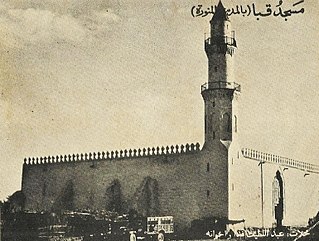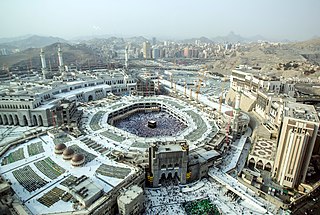A mosque, also called a masjid, is a place of worship for Muslims. The term usually refers to a covered building, but can be any place where Islamic prayers are performed, such as an outdoor courtyard.

Year 622 (DCXXII) was a common year starting on Friday of the Julian calendar, the 622nd year of the Common Era (CE) and Anno Domini (AD) designations, the 622nd year of the 1st millennium, the 22nd year of the 7th century, and the 3rd year of the 620s decade. The denomination 622 for this year has been used since the early medieval period, when the Anno Domini calendar era became the prevalent method in Europe for naming years.

Medina, officially Al-Madinah al-Munawwarah and also commonly simplified as Madīnah or Madinah, is the capital of Medina Province in the Hejaz region of western Saudi Arabia. It is one of the oldest and most important places in Islamic history. One of the most sacred cities in Islam, the population as of 2022 is 1,411,599, making it the fourth-most populous city in the country. Around 58.5% of the population are Saudi citizens and 41.5% are foreigners. Located at the core of the Medina Province in the western reaches of the country, the city is distributed over 589 km2 (227 sq mi), of which 293 km2 (113 sq mi) constitutes the city's urban area, while the rest is occupied by the Hejaz Mountains, empty valleys, agricultural spaces and older dormant volcanoes.

The qibla is the direction towards the Kaaba in the Sacred Mosque in Mecca, which is used by Muslims in various religious contexts, particularly the direction of prayer for the salah. In Islam, the Kaaba is believed to be a sacred site built by prophets Ibrahim and Ismail, and that its use as the qibla was ordained by Allah in several verses of the Quran revealed to Muhammad in the second Hijri year. Prior to this revelation, Muhammad and his followers in Medina faced Jerusalem for prayers. Most mosques contain a mihrab that indicates the direction of the qibla.

Mihrab is a niche in the wall of a mosque that indicates the qibla, the direction of the Kaaba in Mecca towards which Muslims should face when praying. The wall in which a mihrab appears is thus the "qibla wall".

The Prophet's Mosque is the second mosque built by the Islamic prophet Muhammad in Medina, after that of Quba, as well as the second largest mosque and holiest site in Islam, after the Masjid al-Haram in Mecca, in the Saudi region of the Hejaz. The mosque is located at the heart of Medina, and is a major site of pilgrimage that falls under the purview of the Custodian of the Two Holy Mosques.

The Quba Mosque is a mosque located in Medina, in the Hejazi region of Saudi Arabia, built in the lifetime of the Islamic prophet Muhammad in the 7th century C.E. It is thought to be the first mosque in the world, built on the first day of Muhammad's emigration to Medina. Its first stone is said to have been laid by the prophet, and the structure completed by his companions.

Sankoré Madrasa is one of three medieval mosques and centres of learning located in Timbuktu, Mali, the others being the Djinguereber and Sidi Yahya mosques. Founded in the 14th century, the Sankoré mosque went through multiple periods of patronage and renovation under both the Mali Empire and the Songhai Empire until its decline following the Battle of Tondibi in 1591. The mosque developed into a madrasa, reaching its peak in the 16th century. The term "University of Sankoré" has sometimes been applied to the Sankoré madrasa, though there is no evidence of a centralized teaching institution such as the term university implies. Instead the mosque served as the focal point for individual scholars with their own private students, and as a location in which some lectures and classes were held.

The Cheraman Juma Mosque is a popular pilgrim centre in Kodungallur in Thrissur district. According to hagiographical legends, it is claimed that the mosque was built in 629 CE by Malik Bin Dinar.

The holiest sites in Islam are predominantly located in the Arabian Peninsula and the Levant. While the significance of most places typically varies depending on the Islamic sect, there is a consensus across all mainstream branches of the religion that affirms three cities as having the highest degree of holiness, in descending order: Mecca, Medina, and Jerusalem. Mecca's Al-Masjid al-Haram, Al-Masjid an-Nabawi in Medina and Al-Masjid al-Aqsa in Jerusalem are all revered by Muslims as sites of great importance.

The Masjid al-Qiblatayn, also spelt Masjid al-Qiblatain, is a mosque in Medina believed by Muslims to be the place where the final Islamic prophet, Muhammad, received the command to change the Qibla from Jerusalem to Mecca. The mosque was built by Sawad ibn Ghanam ibn Ka'ab during the year 2 AH and is one of the few mosques in the world to have contained two mihrabs in different directions.

The Kaaba, sometimes referred to as al-Ka'ba al-Musharrafa, is a stone building at the center of Islam's most important mosque and holiest site, the Masjid al-Haram in Mecca, Saudi Arabia. It is considered by Muslims to be the Bayt Allah and is the qibla for Muslims around the world. The current structure was built after the original building was damaged by fire during the siege of Mecca by Umayyads in 683 AD.

Both Sunni Muslims and Shia Muslims agree on the three holiest sites in Islam being, respectively, the Masjid al-Haram, in Mecca; the Al-Masjid an-Nabawi, in Medina; and the Al-Masjid al-Aqsa, in Jerusalem.

Both Sunni Muslims and Shia Muslims agree on the three Holiest sites in Islam being, respectively, the Masjid al-Haram, in Mecca; the Al-Masjid an-Nabawi, in Medina; and Al-Masjid al-Aqsa, in Jerusalem.
The demolition or burning of Masjid al-Dirar , or the Mosque of Dissent, is mentioned in the Qur'an. Masjid al-Dirar was a Medinian mosque that was erected close to the Quba Mosque and which the Islamic prophet Muhammad initially approved of but subsequently had destroyed while he was returning from the Expedition to Tabouk. In the main account narrated by the majority of scholars, the mosque was built by 12 hypocrites (munafiqeen) on the commands of Abu 'Amir al-Rahib; a Hanif who refused Muhammad's invitation to Islam and instead fought along with the Meccan non-Muslims against Islam in the Battle of Uhud. Abu 'Amir reportedly urged his men to establish a stronghold and prepare whatever they can of power and weapons as he promised and insinuated to them that he will lead an army, backed by Heraclius, to fight Muhammad and his companions, and defeat his message by expelling him from Medina. Ahmad ibn Yahya al-Baladhuri also relates that the men, who built the Al-Dirar mosque "for mischief and for infidelity and to disunite the Believers" refused to pray in Quba Mosque claiming that it was built in a place where a donkey used to be tied up.

Masjid al-Haram, also known as the Sacred Mosque or the Great Mosque of Mecca, is considered to be the most significant mosque in Islam. It encloses the vicinity of the Kaaba in Mecca, in the Mecca Province of Saudi Arabia. It is among the pilgrimage sites associated with the Hajj, which every Muslim must perform at least once in their lives if able. It is also the main site for the performance of ʿUmrah, the lesser pilgrimage that can be undertaken any time of the year. The rites of both pilgrimages include circumambulating the Kaaba within the mosque. The Great Mosque includes other important significant sites, such as the Black Stone, the Zamzam Well, Maqam Ibrahim, and the hills of Safa and Marwa.
The following is a timeline of the history of the city of Medina, Saudi Arabia.
The following is a timeline of the history of the city of Mecca, Saudi Arabia.

Al Jum'ah Mosque is a mosque in Medina, in the Hejazi region of Saudi Arabia. Also known as Masjid Banī Sālim, Masjid Al-Wādī, Masjid Al-Qubayb, and Masjid ʿĀtikah, it is said by the locals to be where the Islamic prophet Muhammad and his companions performed Salatul-Jumu'ah for the first time, during their hijrah (migration) from Mecca to Medina.


















